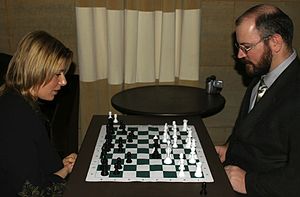| Revision as of 20:24, 26 January 2009 editOli Filth (talk | contribs)Extended confirmed users, Pending changes reviewers, Rollbackers18,040 edits rv one further edit - this kind of commentary isn't appropriate for the article space; if you don't believe the claim is sourced, then use a {{citation needed}} template← Previous edit | Revision as of 20:28, 26 January 2009 edit undoDonaldstrumpcard (talk | contribs)19 edits Undid revision 266595436 by Oli Filth (talk) If you check the link Trice cited, you will see he is incorrect in his claim.Next edit → | ||
| Line 15: | Line 15: | ||
| ==Chess== | ==Chess== | ||
| Trice wrote a ] program called The Sniper, which in April 1987, was the first ] to eclipse the ] of 2200, which is equivalent to that of "] Master", roughly four years after the ] became the first ever ''hardware'' machine to earn the Master title.<ref>{{cite journal|author=Dunne A|title=Check is in the Mail|journal=Chess Life|pages=32-34|year=1991|month=Dec}}</ref> | Trice wrote a ] program called The Sniper, which in April 1987, which he claims ( no reference of proof given)was the first ] to eclipse the ] of 2200, which is equivalent to that of "] Master", roughly four years after the ] became the first ever ''hardware'' machine to earn the Master title.<ref>{{cite journal|author=Dunne A|title=Check is in the Mail|journal=Chess Life|pages=32-34|year=1991|month=Dec}}</ref> | ||
| In 1989, he won an exhibition game against the ] chess program in 20 moves,<ref>{{cite web|url=http://www.chessgames.com/perl/chessgame?gid=1272214|title=Ed Trice vs. Deep Thought|accessdate=2009-15-01}}</ref> its quickest loss ever.<ref>{{cite web|url=http://www.chessgames.com/perl/chess.pl?pid=13728&result=2nd|title=Losses of Deep Thought|accessdate=2009-15-01}}</ref> |
In 1989, he won an exhibition game against the ] chess program in 20 moves,<ref>{{cite web|url=http://www.chessgames.com/perl/chessgame?gid=1272214|title=Ed Trice vs. Deep Thought|accessdate=2009-15-01}}</ref> its quickest loss ever.<ref>{{cite web|url=http://www.chessgames.com/perl/chess.pl?pid=13728&result=2nd|title=Losses of Deep Thought|accessdate=2009-15-01}}</ref> | ||
| == Checkers == | == Checkers == | ||
Revision as of 20:28, 26 January 2009
| Ed Trice | |
|---|---|
 | |
| Full name | Edward A. Trice |
| Country | |
Edward A. Trice (born December 5, 1966 in Philadelphia, Pennsylvania) is an American inventor and entrepreneur. He invented a chess variant known as Gothic Chess, and has created several chess and checkers programs.
Gothic Chess
Main article: Gothic Chess
In 2000, Trice patented the commercial chess variant Gothic Chess, derived from Capablanca Chess. This variant differs from Capablanca Chess in the initial positioning of some of the back-row pieces.
Chess
Trice wrote a chess program called The Sniper, which in April 1987, which he claims ( no reference of proof given)was the first software program to eclipse the Elo performance rating of 2200, which is equivalent to that of "United States Chess Federation Master", roughly four years after the Belle chess machine became the first ever hardware machine to earn the Master title.
In 1989, he won an exhibition game against the Deep Thought chess program in 20 moves, its quickest loss ever.
Checkers
In 2003, Trice and Gil Dodgen demonstrated that it was possible for a checkers program to fail to win a theoretically-won position with as few as seven pieces on the board (four for the winning side, three for the side that should lose). Their World Championship Checkers computer program was the first to use their database and methodologies. In 2007, Jonathan Schaeffer solved the game of checkers, and acknowledged Trice and Dodgen's database verification.
References
- "Ed Trice vs. Susan Polgar". Retrieved 2007-10-25.
- Trice E (2004). "80-Square Chess" (PDF). ICGA Journal. 27 (2): 81–96. Retrieved 2007-07-28.
{{cite journal}}: Unknown parameter|month=ignored (help) - Dunne A (1991). "Check is in the Mail". Chess Life: 32–34.
{{cite journal}}: Unknown parameter|month=ignored (help) - "Ed Trice vs. Deep Thought". Retrieved 2009-15-01.
{{cite web}}: Check date values in:|accessdate=(help) - "Losses of Deep Thought". Retrieved 2009-15-01.
{{cite web}}: Check date values in:|accessdate=(help) - Trice E, Dodgen G (2003). "The 7-Piece Perfect Play Lookup Database for the Game of Checkers" (PDF). ICGA Journal. 26 (4): 229–238. Retrieved 2009-01-15.
{{cite journal}}: Unknown parameter|month=ignored (help) - "World Championship Checkers website". Retrieved 2007-07-27.
- Schaeffer, J (2007-07-19). "Checkers Is Solved". Science. Retrieved 2007-07-20.
- Schaeffer, J. "Acknowledgements". Retrieved 27 July.
{{cite web}}: Check date values in:|accessdate=(help); Cite has empty unknown parameter:|1=(help); Unknown parameter|accessyear=ignored (|access-date=suggested) (help)